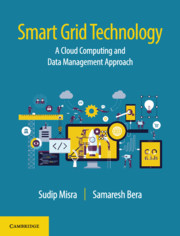Book contents
- Frontmatter
- dedication
- Contents
- Figures
- Tables
- Foreword
- Preface
- Part I Introduction
- Part II Cloud Computing Applications for Smart Grid
- 5 Demand Response
- 6 Geographical Load-Balancing
- 7 Dynamic Pricing
- 8 Virtual Power Plant
- 9 Advanced Metering Infrastructure
- 10 Cloud-Based Security and Privacy
- Part III Smart Grid Data Management and Applications
- Part IV Smart Grid Design and Deployment
- Index
7 - Dynamic Pricing
from Part II - Cloud Computing Applications for Smart Grid
Published online by Cambridge University Press: 20 October 2018
- Frontmatter
- dedication
- Contents
- Figures
- Tables
- Foreword
- Preface
- Part I Introduction
- Part II Cloud Computing Applications for Smart Grid
- 5 Demand Response
- 6 Geographical Load-Balancing
- 7 Dynamic Pricing
- 8 Virtual Power Plant
- 9 Advanced Metering Infrastructure
- 10 Cloud-Based Security and Privacy
- Part III Smart Grid Data Management and Applications
- Part IV Smart Grid Design and Deployment
- Index
Summary
With the implementation of bi-directional communication facility, service providers have real-time information about energy consumption by the customers and energy production by the generators. In such cases, dynamic pricing based mechanisms are more appealing than traditional static pricing based ones. Service providers decide real-time price based on the demand from customers or supply from the generation side or both the supply and demand. Consequently, customers have the opportunity to use electricity according to their preferred real-time price decided by the grid. Additionally, service providers maintain the real-time supply–demand curve by controlling the real-time price. When demand increases, the price may be increased to reduce the extra load from the grid, and vice-versa. Customers also schedule their energy consumption depending on the real-time price decided by the grid. Therefore, dynamic pricing policy is one of the important features of the smart grid that provides dynamic load balancing in the smart grid.
Deployment of Dynamic Pricing in Smart Grids
As the name suggests, in dynamic pricing, the price of energy varies over time according to the energy supply or demand or both. To implement the dynamic energy pricing policy, we need to address several challenges that will be discussed in this section.
Determination of actual timeslot
We discussed earlier that there are three different time-slots in the smart grid – on-peak, mid-peak, and off-peak. Based on the past days’ behavior, state (on, mid, or off-peak) of a particular time-slot is determined. For example, the office hour can be considered as on-peak, the morning and evening can be considered as mid-peak, and night can be considered as off-peak. However, in real-time, the situation in the grid may be different. For example, energy demand on a particular day may be different from another day. Moreover, as the smart grid is equipped with renewable energy sources, which are intermittent in nature, energy supply to the grid may also vary over multiple days. Therefore, it is not possible to blindly say that a particular time period is mid-peak, or on-peak, or off-peak. Consequently, it is important to define suitable strategies to determine the state of a time-slot.
- Type
- Chapter
- Information
- Smart Grid TechnologyA Cloud Computing and Data Management Approach, pp. 96 - 105Publisher: Cambridge University PressPrint publication year: 2018



